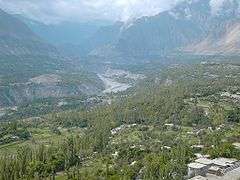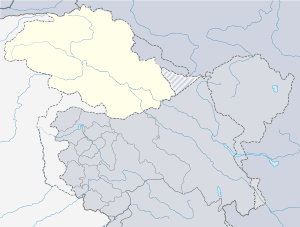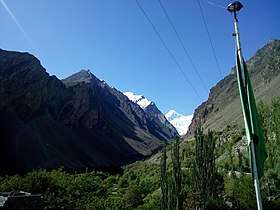Nagar, Pakistan
| District Nagar ضلع نگر | |
|---|---|
 | |
 Nagar  Nagar | |
| Coordinates: 35°14′N 73°29′E / 35.24°N 73.48°ECoordinates: 35°14′N 73°29′E / 35.24°N 73.48°E | |
| Country |
|
| Autonomous state | Gilgit–Baltistan |
| Elevation | 2,688 m (8,819 ft) |
| Time zone | UTC+5 (PST) |
Nagar (Urdu:نگر) (formerly State of Nagar) is a district with namesake town as district's headquarter, in northmost autonomous territory of Gilgit–Baltistan. It was created in 2015 by subdividing the Hunza-Nagar District.
It is located at 35°24'0N 73°48'0E with an altitude of 2688 metres (8822 feet).[1]
Today, the famous Karakoram Highway crosses Nagar, connecting Pakistan to China via the Khunjerab Pass. The road follows the Hunza-Nagar River for some distance through Nagar and into the hunza region.
Location


The Nagar valley previously known as Broshal, is situated at an elevation of 2,438m (7,999 feet). Nagar Khas is the main town and the capital of the former State of Nagar. Ghulmet, Minapin, BAR, Chaprote and Hopper Valleys are popular tourist attractions in the Nagar region because of the spectacular scenery of the surrounding and the most intimidating high mountain peaks on earth such as Rakaposhi at 7,788m (25,561 feet), and Diran, and Spantik peak also known as (Golden peak) and several others to be discovered.
History
Following the Hunza-Nagar Campaign of 1889–1892 (known locally as the Anglo-Burusho war) the area passed under British control and then as a vassal of the Kashmir Durbar, but was ruled by the same royal family. In 1974, Zulfiqar Ali Bhutto dissolved the Princely States of Nagar and Hunza and gave democratic representation to the Northern Areas Council, now known as the Northern Areas Legislative Council.The British wanted to expand their trade to Russia from here, but the states wouldn’t allow them to.
| Reign | Mirs of Nagar[2] |
|---|---|
| Unknown dates | Fadl Khan |
| Unknown dates | Daud Khan |
| Unknown dates | Ali Dad Khan (1st time) |
| Unknown dates | Hari Tham Khan |
| Unknown dates | Ali Dad Khan (2nd time) |
| Unknown dates | Kamal Khan |
| Unknown dates | Rahim Khan I |
| Unknown date – 1839 | Rahim Khan II |
| 1839–1891 | Jafar Zahid Khan (1st time) |
| 1891–1892 | Raja Azur Khan (acting) |
| 1892–1904 | Jafar Zahid Khan (2nd time) |
| 1905 – 17 March 1940 | Raja Mir Iskandar Khan |
| 17 March 1940 – 25 September 1974 | Shaukat Ali Khan (1930–1976) |
| 25 September 1974 | State of Nagar dissolved |
| After Nagar State dissolved in 1974 | Elected Representatives of Nagar in Gilgit-Baltistan Legislative Council |
| 1975– | Syed Yahya Shah |
| 1980– | Mir Shaukat Ali Khan |
| 1985– | Qurban Ali |
| 1997– | Mir Shaukat Ali Khan-Nagar-1, Sheikh Ghulam Haider-Nagar-2, |
| 2000– | Qurban Ali-Nagar-1, Sheikh Ghulam Haider-Nagar-2 |
| 2005– | Mirza Hussain-Nagar-1, Muhammad Ali Akhtar-Nagar-2 |
| 2009– | Mirza Hussain-Nagar-1, Muhammad Ali Akhtar-Nagar-2 |
| 2015– | Rizwan Ali-Nagar-1, Muhammad Ali Haider-Nagar-2 |
| 2017– | Javed Hussain-Nagar-2 (by-elections July 2017)[3] |
Royal titles and styles
The name for the ruler in Nagar was Thum (تھم) in Brushaski and (Ra-را) in Shina language, which is also a respectful appellation used by people of both Hunza and Nagar who belong to the clan of Boorish. The titles for prince and princess and the styles of Highness and Royal Highness for members of the Royal Family are still used here. In Hunza and Nagar Royal family men are called Gushpoor (گشپور) and Royal family women are titled as Soni (سونی).
References
- ↑ Location of Nagar - Falling Rain Genomics
- ↑ Ben Cahoon, WorldStatesmen.org. "Pakistan Princely States". Retrieved 2007-10-03.
- ↑ http://pamirtimes.net/2017/07/09/ppps-javed-hussain-claims-victory-in-nagar-by-elections/
Further reading
- Leitner, G. W. (1893): Dardistan in 1866, 1886 and 1893: Being An Account of the History, Religions, Customs, Legends, Fables and Songs of Gilgit, Chilas, Kandia (Gabrial) Yasin, Chitral, Hunza, Nagyr and other parts of the Hindukush, as also a supplement to the second edition of The Hunza and Nagyr Handbook. And An Epitome of Part III of the author’s “The Languages and Races of Dardistan.” First Reprint 1978. Manjusri Publishing House, New Delhi.
- Where three Empires meet by E.F.Night.
- Buroshall Say Nagar Tak ka Safar by Mohammad Ismail Tehseen.
- Brushaal Ke Qabail by Syed Yahya Shah
- Rakaposhi Nagar (راکاپوشی نگر) (Travelogue, 2015) by Mustansar_Hussain_Tarar